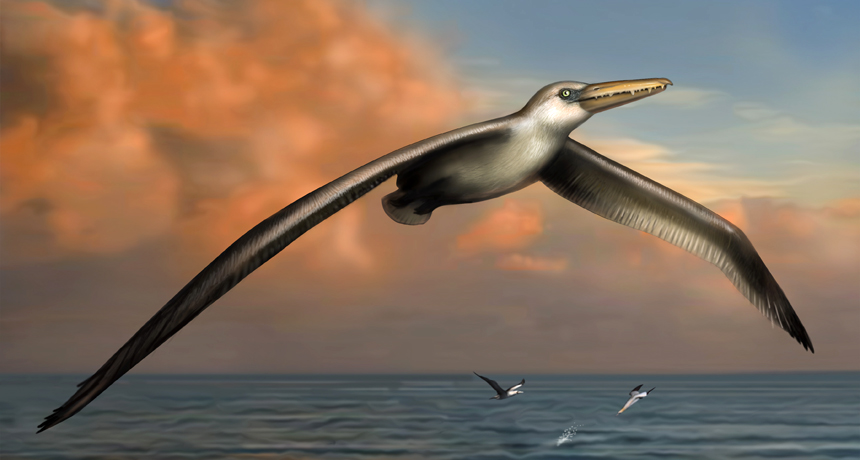Mega-bird!
Its massive wings should have made this now-extinct bird a supremely good glider

Artist’s impression of what a gliding Pelagornis sandersi would have looked like.
Image courtesy of Liz Bradford
A partial skull and a handful of other bones is all that’s left of one enormous bird. Construction workers unearthed its fossil parts three decades ago near Charleston International Airport in South Carolina. But this animal predated that airport and any nearby towns by some 28 million years. Now scientists think they’ve answered an important question about this supersized bird: Could it fly? And their conclusion: Not by using its wings alone.
This Pelagornis sandersi had a wingspan of 6.4 meters (21 feet). That’s about half the length of a city bus. It’s also twice the wingspan of the biggest living flier, the wandering albatross. (Indeed, P. sandersi vies with only one other extinct bird — Argentavis magnificens — as the biggest to ever take to the air.) Scientists had thought that no albatross-like bird of such gargantuan size would have been able to get off the ground.
Daniel Ksepka now works at the Bruce Museum in Greenwich, Ct. But until recently, he worked at the National Evolutionary Synthesis Center in Durham, N.C. (which is jointly run by three major universities.) There, he fed the dimensions of this mega-bird into a computer program. That program had been designed to evaluate flight capabilities based on a bird’s skeleton. P. sandersi’s long wings would have cut drag — friction from the air, the computer found. This should have allowed the bird to soar long distances.
It’s not clear whether the big bird also flapped to power its flight. It could, however, have launched with a running takeoff, Ksepka reports July 7 in the Proceedings of the National Academy of Sciences.
This bird’s gliding skills might have been similar to that of the modern day albatross, which can remain aloft for hours without flapping its wings. And Ksepka’s calculations indicate P. sandersi had the capacity for swift flight. It might have traveled at up to 17 meters (55 feet) per second, he says. That would be 59 kilometers (37 miles) per hour!
When it comes to birds, “Larger sizes lead to greater soaring efficiency,” Ksepka says. And compared to a modern albatross, P. sandersi had much longer wings compared to its weight and body size. Still, this bird would have been at about the upper range of sizes that could have landed on the ocean and then taken off again. And that’s important because this bird likely fed on fish.
It’s possible, however, that this supersized flier merely plucked its meals from the ocean surface while gliding by. This bird’s mouth would have had great gripping and trapping properties, Ksepka notes, due to its pseudoteeth. These spikey bits of interlocking tooth-shaped bone protruded from its jaws.
Power Words
albatross A type of large seabirdwith webbed feet and slender wings. Albatrosses are powerful gliders and spend most of their lives over the ocean, scooping up fish and squid from the water’s surface.
birds Warm-blooded animals with wings that first showed up during the time of the dinosaurs. Birds are jacketed in feathers and produce young from the eggs they deposit in some sort of nest. Most birds fly, but throughout history there have been the occasional species that don’t.
drag A slowing force exerted by air or other fluid surrounding a moving object.
lift An upward force on an object. It may occur when an object (such as a balloon) is filled with a gas that weighs less than air; it can also result when a low-pressure area occurs above an object (such as an airplane wing).







